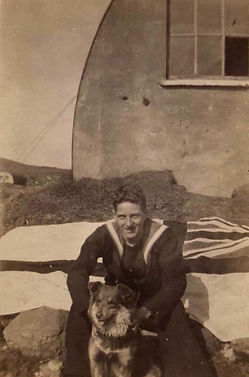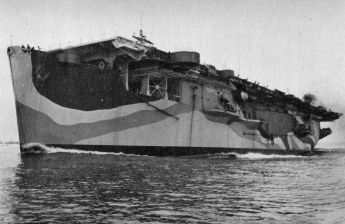

Ray Shufflebottom
His Wartime Days In The Royal Navy
Enlisting and HMS Lightfoot
When WW2 broke out, Ray was still a 14-year-old student living at his family home at Springwood, Chesterton, in North Staffordshire. Ray’s first job after leaving school was as a machinist at the BSA factory in Newcastle, but as the almost certain arrival of his call up papers drew nearer; he decided to enlist in the service of his own choice.
Therefore, at the age of 17, Ray applied to join the Royal Navy. He took and passed his medical examination on the 13th February 1943, but it was not until the 27th September that he received his enlistment notice. He was instructed to present himself on Monday 4th October at HMS Ganges, the onshore naval training base on the Shotley peninsular in Essex.



His training at HMS Ganges lasted for 3 months and included such joys as being taken out to sea to learn how to swim, only being allowed back on shore after completing enough strokes to satisfy his instructor. Ray also remembers having to climb the famous wooden mast. After completing his naval training, he was ordered to report to the drill hall at HMS Pembroke, the naval base at Chatham. This was to be Ray’s home base for the duration of his naval service.
The posting to his first ship was short lived, for soon after he had received instructions to join his ship, its mission to protect a Baltic convoy was cancelled. Ray cannot recall the ships name but he remembers that sometime later that year, this particular ship was lost with all hands while on convoy duty in the Baltic.
Within days he was re-assigned to another ship, the mine sweeper HMS Lightfoot, and was told to make his way immediately to Leith in Scotland to join the ship. He was on the Lightfoot in Leith for only 10 to 14 days while the ship’s crew was assembled after which she sailed for Tobermory on the Isle of Mull. Local people in Tobermory vividly remember the large amount of ships moored out in the bay, the majority
of them were on some sort of training, anti-submarine, mine sweeping and so on. Even the commandoes who were training nearby made mock raids on the port. It was here that Lightfoot and her crew underwent mine sweeping training before going on active duty.

HMS Lightfoot seen here in 1948 under the Greek flag
HMS Lightfoot was just one of many ex-US and Canadian Algerine class minesweepers used by the Royal Navy during the war. After being transferred to Britain on the 14th December 1942, Lightfoot was joined by four other ships on mine sweeping duties.
They operated five abreast with chains between each ship, attempting to sever the contact mines anchor chains on the seabed. The mines would then be released and float to the surface where they were shot at in an attempt to hole them below water level, allowing sea water to enter and render the explosives safe. Ray recalls the times that he had to arm depth charges prior to firing, another method of disposing with the mines.
These operations took place between the West Coast, Pentland Firth and the upper regions of the North Sea, and were to continue for several months during early 1944. The last duty that the Lightfoot performed before she left this area was to escort a stricken submarine from the North Sea into Dundee.
D-Day was fast approaching, so the Lightfoot was ordered south to join the flotilla of ships gathering in the Solent in preparation for the Normandy landings. The sight of so many ships gathered in one place was an ‘incredible experience’ says Ray.
As the preparations continued for the D-Day landings on the 6th June 1944, Ray had to be taken ashore to undergo an operation in Portsmouth hospital. After only two or three days, he was transferred to Winchester hospital and then on to the Queen Elizabeth hospital in Birmingham. Ray’s short stay in these south coast hospitals was because of the freeing up of as many beds as possible in preparation for expected D-Day casualties. After ten days in the QE hospital, he was on his way home to Chesterton for a spell of leave.


Above are some images of Ray during his service at the Boulder 3 station in Iceland. The top-left hand picture shows Ray in front of the communications hut where he spent most of his time. The desolate Icelandic landscape around the Val Fjord can be seen clearly on the top-right hand photo.
Iceland and HMS Tracker
After some home leave to recuperate from his operation, Ray returned to Chatham where he received his next posting. He was to spend the next nine months at a refuelling station in Iceland. The station, which was code-named Boulder 3, was situated about 30 miles from Reykyavik along the Val Fjord. It was one of three ‘Boulder’ stations in Iceland, Boulder 1 being in Reykyavik.
Ray worked in the communications hut when on duty, but with little to do in his leisure time, he spent most of the time at his workplace. Recreation was confined to either bingo or the station’s cinema. Reykyavik was about 30 miles away by road and took around three hours by bus or lorry on the rough lava roads, meaning that there was little opportunity to spend time there. The boat trip was less rough but took over four hours.
The war in Europe was ending, so Ray was recalled to his home base in Chatham. He returned via Liverpool and took some home leave before reaching Chatham to be given his next posting. His posting was not immediate; he spent some weeks at Chatham but was billeted at Southend on Sea. This was a considerable distance away by land, and the rail journey into London and then onto Southend took a considerable time, but the recreational and leisure time pursuits made it worthwhile.
His posting eventually came through. He was to join HMS Tracker in Rosyth and sail to the Far East in support of the war which was still going on out there. With the posting being potentially long and such a great distance from home, Ray was given home leave before sailing. During this leave, Ray met another local lad at the pub, Ken Billington, who told him that he was also on his was to join Tracker, but he was due there a couple of days later than Ray.
Before Tracker could set sail, its mission to the Far East was cancelled following the Japanese surrender. It was now ordered to set sail for Southampton were it took on board American GI’s who were returning home after the end of the war in Europe.
Although Ray cannot remember exact dates as to these events, history reveals that it must have been around August 15th 1945, the date of the Japanese surrender, and records show that HMS Tracker would have been there at that time.



HMS Lightfoot
Not much is known about HMS Lightfoot other than she was one of thirty-one Algerine class minesweepers which were supplied to the Royal Navy by the US and Canada between 15th August 1942 and 15th June 1944. After mine sweeping duties with the Royal Navy, she was returned to the US Navy in December 1946 and then sold to Greece on 1st February 1948.
HMS Tracker
More is known about HMS Tracker (D24), a Bogue class escort carrier. She was originally built to be the merchantman Mormacmail at the Tacoma shipyards. Before she had been completed, the US Navy purchased the ship and she was converted to escort carrier BAVG-6 during 1942 at Portland, Oregon. Early in 1943, she was transferred to the Royal Navy and renamed HMS Tracker. Tracker had a distinguished career during her time with the Royal Navy. She served as a convoy escort in the North Atlantic and the Baltic, and she was part of the naval screen for the D-Day landings. In November 1944, Tracker was loaned back to the US Navy to be used to ferry aircraft and personnel in the Pacific.
She returned to the UK early in August 1945 and was allocated to the reserve fleet. She was due to leave for the Far East during August, but with the Japanese surrender, the sailing was cancelled. She was returned to the USN at the Norfolk Navy Yards on 29th November 1945. During 1946 she was sold into merchant service and became the Argentinean vessel Corrientes. She was scrapped at Antwerp in September 1964.
Below are images of a naval ratings railway ticket and a leave pass issued to Ray in 1945. These should had been handed in immediately after being used. After over 60 years, we do not think it will matter too much!




Rosyth as an Air Lighter
Ray was now posted to Rosyth and was to become an aircraft lighter. After the end of WW2 some of the aircraft aboard aircraft carriers and escort carriers were unserviceable and therefore incapable of flying off to land bases. It was the job of the air lighters to manually remove these aircraft from the carriers using smaller craft and to land them ashore. The majority of the unserviceable and damaged aircraft were Swordfish. The task of removing these aircraft was considerable so Ray was stationed here for many months before being posted.

Ray is seen here with some of his air lighter friends at Rosyth
Greenock
It was now September 1946 and Ray was expecting to be de-mobbed, but he was posted instead to the RN air base at Greenock. His duties there were various, from working on the main gate to occasionally helping to police the town and keep an eye on sailors having a bit of ‘leisure time’. On one occasion, Ray was sent all the way to Preston prison to escort a prisoner back to Greenock. Apparently, this sailor had been accused of stealing a typewriter. Ray arrived at Preston prison at night and was too late to catch a train back or even too late to find some accommodation. He had to spend the night in a prison cell, unlocked of course.
Ray was not to return to Chatham again, he was eventually de-mobbed in 1947 at Greenock although he had to return home via York to pick up his de-mob suit. In common with most de-mobbed service personnel, he became a naval reservist. During the Suez crisis, Ray was recalled to serve in the Navy once more, but by this time, he was in a reserved occupation, rebuilding military tanks at the Apedale Tank Factory.



